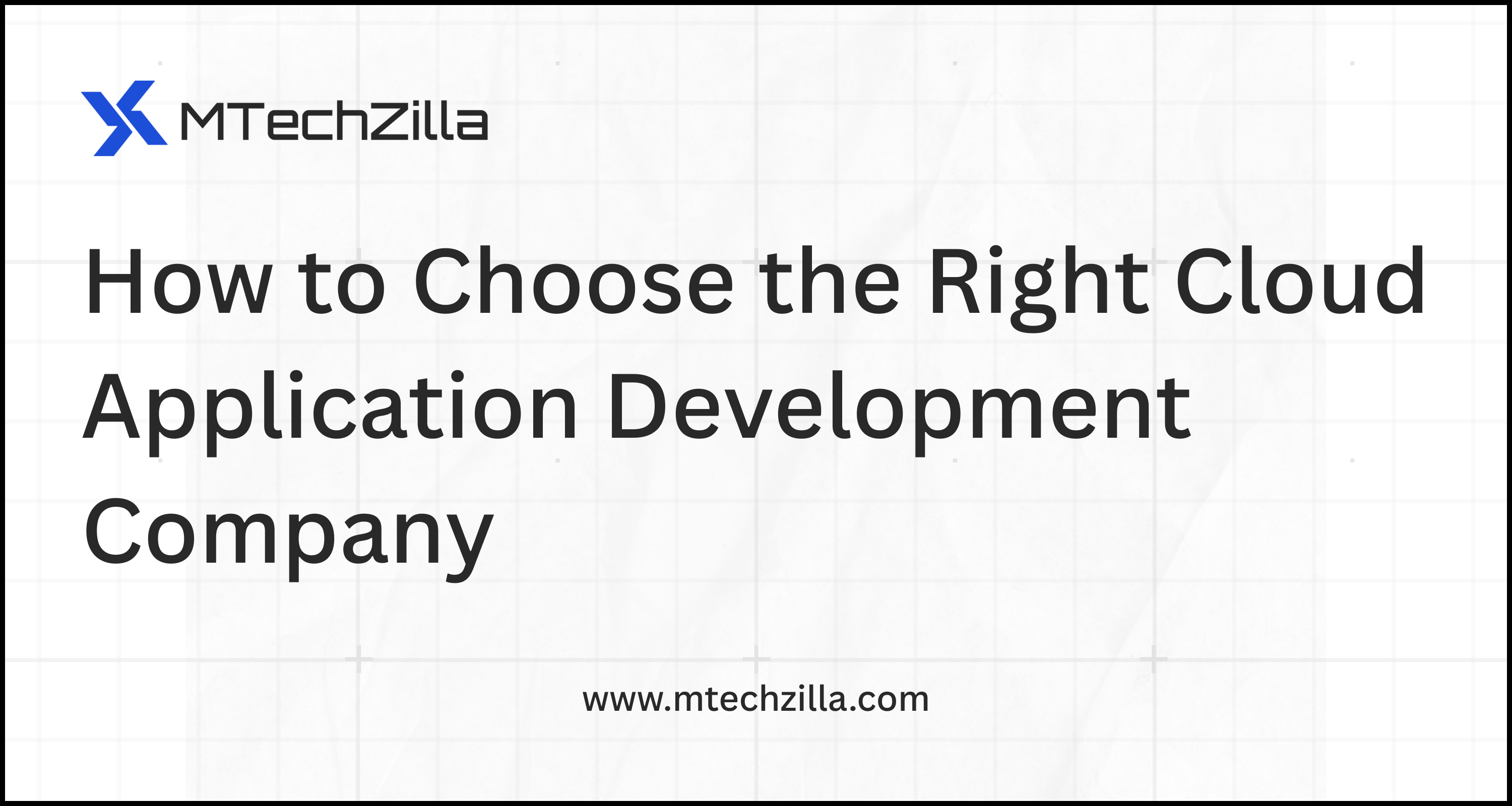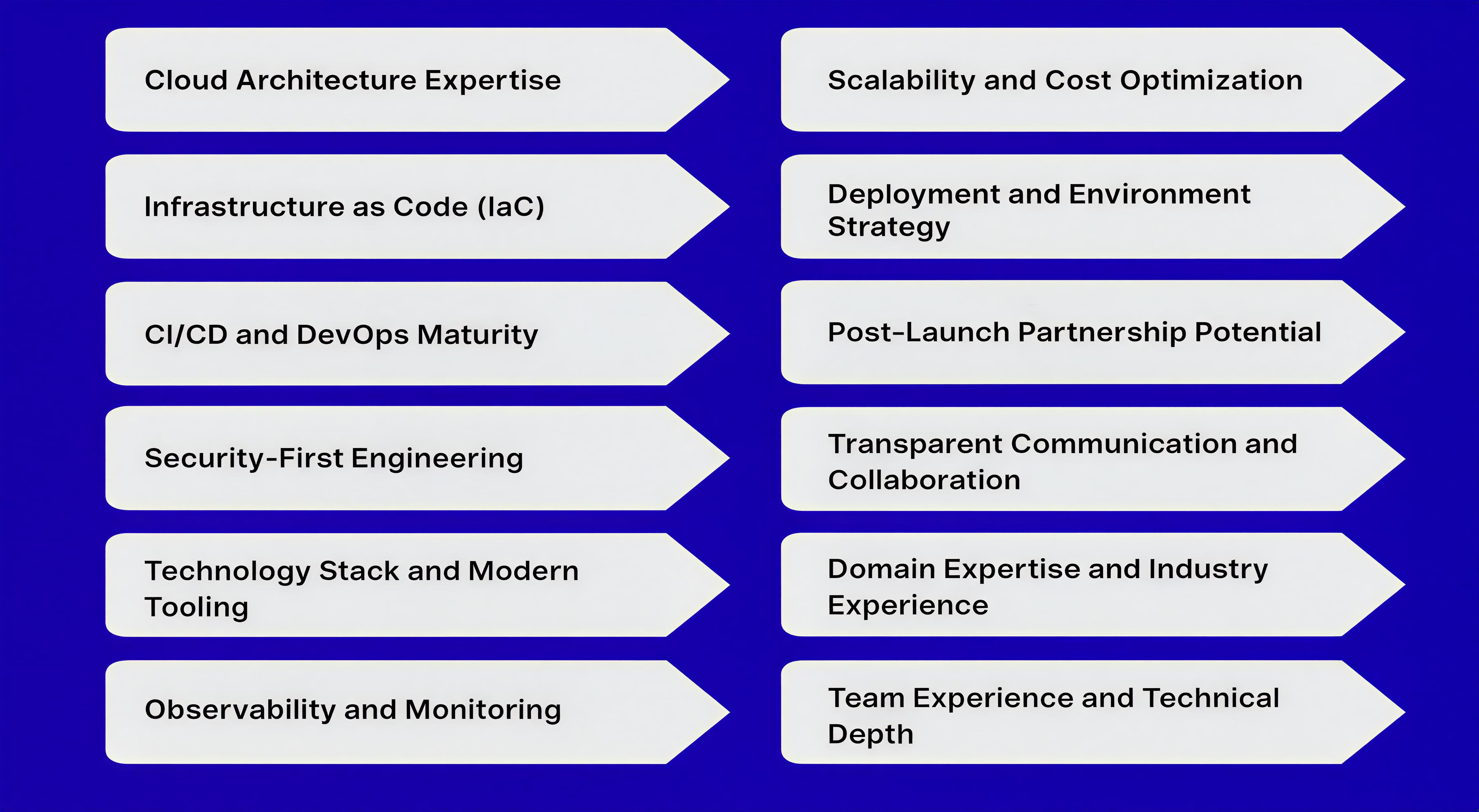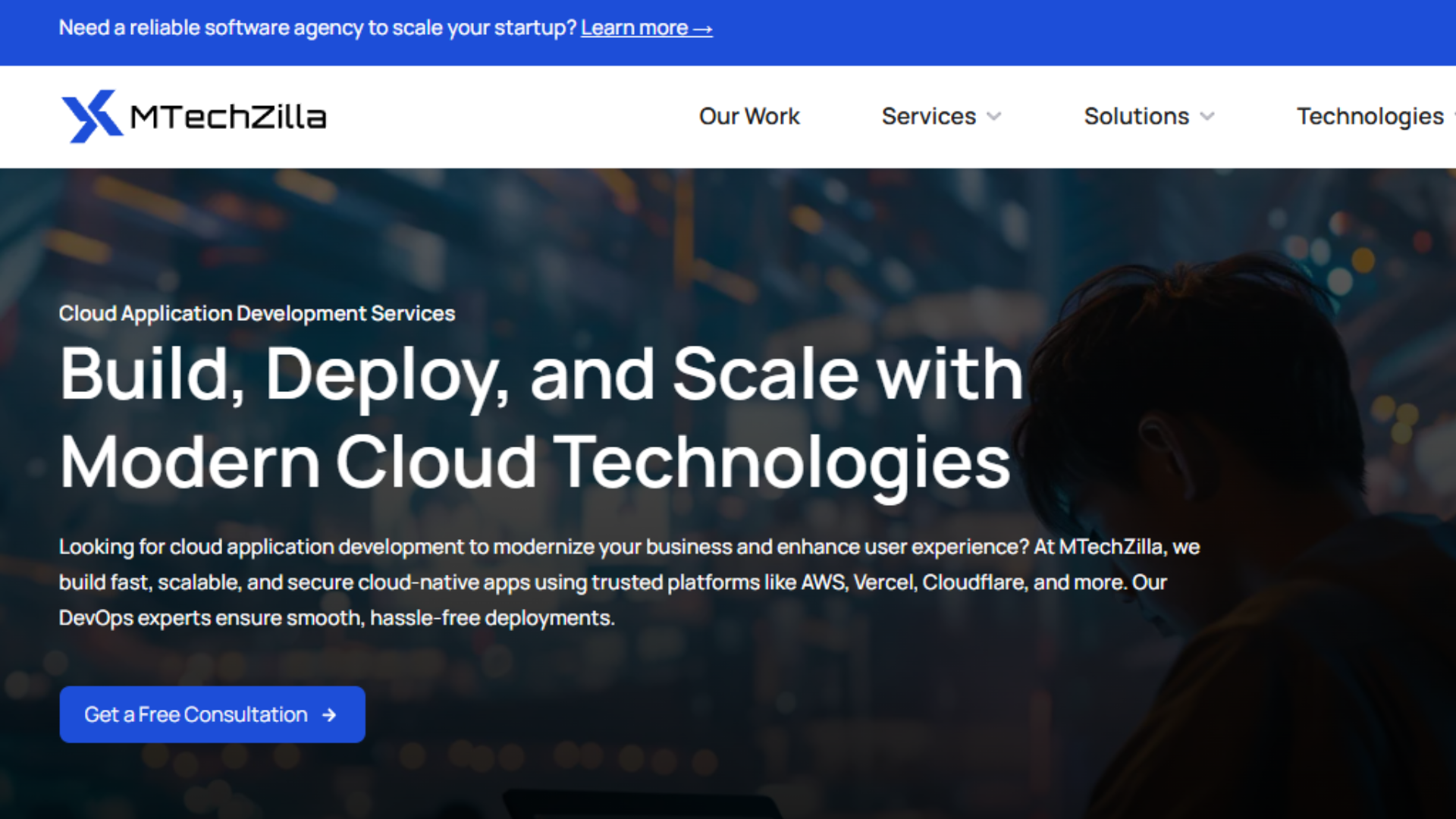November 4, 2025
10 min read

From the past seven years, we’ve worked with, guided, and audited many cloud development teams, from early-stage startups to large enterprises.
We have observed that when companies look for vendors, they often focus only on proposals, timelines, or cost. However, the real difference between choosing the right vendor and making an expensive mistake becomes clear after launch - when traffic increases, updates cause system errors, or compliance audits take place. That’s when a team’s technical strength and maturity become visible.
In this blog, we’ll walk you through a clear and practical approach to help you choose the right cloud application development company, based on real practices, proven methods, and lessons learned from years of experience in cloud development.
Introduction
What is Cloud Application Development?
Why Companies Should Invest in Cloud Application Development
Key Considerations for the Right Cloud Application Development Company
Additional Considerations for Choosing a Cloud Partner
MTechZilla’s Approach to Cloud Application Development
Cloud application development refers to the process of building software applications that operate using cloud-based infrastructure rather than relying solely on local computers or on-premise servers.
These applications are created, deployed, and managed on cloud platforms such as AWS, Google Cloud, or Microsoft Azure, which provide computing power, databases, and storage through the Internet.
Cloud-based applications work by splitting their structure into two main parts:
The client side, which includes everything users see and interact with - like buttons, dashboards, or forms.
The server side, which runs in the cloud and handles processing, data management, authentication, and business logic.
Key characteristics of cloud applications include:
The app’s data and core operations are stored and executed on cloud servers, so users don’t need powerful hardware to run them.
Some data can be cached locally, allowing the app to work offline and automatically sync updates once an internet connection is restored.
Developers use modern tools such as APIs, serverless functions, containerised environments, and cloud databases to make the app scalable and efficient.
Users can access the app from anywhere through a browser or mobile device, as all the necessary data and logic are handled securely in the cloud.
According to a 2025 report by Statista and Synergy Research Group, global spending on cloud infrastructure services grew by nearly 25% year over year, reaching $99 billion in Q2 2025 alone.
The report also shows that Amazon Web Services, Microsoft Azure, and Google Cloud continue to dominate the market, together holding over 60% of the global share.
This rapid growth clearly shows how businesses worldwide are investing heavily in cloud infrastructure to support scalability, data management, and AI-driven workloads. In precise terms, the benefits are:
Scalability: Cloud apps automatically scale compute and storage using tools like auto-scaling or Kubernetes, so systems handle user spikes without manual intervention.
Cost Efficiency: Serverless and auto-scaling models ensure you pay only for actual usage. Resource tagging and monitoring make cost control part of development, not just finance.
Speed: Cloud-based CI/CD pipelines enable rapid builds, testing, and zero-downtime deployments, allowing faster releases and safe rollbacks.
Security: Built-in IAM, encryption, and secrets management (like AWS KMS or Azure Key Vault) provide strong security with minimal developer overhead.
Now let’s move straight to the factors to consider when selecting the best cloud application development company for you.
Over the years, we’ve learned that the best partners combine strong engineering depth with operational discipline. Below are the 10 essential factors every business should evaluate to avoid costly mistakes and ensure long-term success.

A strong cloud development company should be fluent in designing systems that scale automatically and recover from failures seamlessly. They must know when to use serverless, containerised, or microservices-based architectures depending on business needs.
What to look for:
Proven experience with AWS, Azure, or Google Cloud architecture design.
Knowledge of scalability models, such as auto-scaling groups, load balancers, and multi-region deployments.
Clear understanding of how to manage traffic bursts and latency using CDN services like Cloudflare or AWS CloudFront.
Manual setup leads to inconsistencies and human errors. A capable company uses Infrastructure as Code to automate cloud configuration.
Key aspects to assess:
Experience with Terraform, AWS CDK, or Pulumi to define infrastructure as reusable templates.
Version-controlled repositories where the full environment can be rebuilt from code.
Ability to replicate production setups in staging environments in minutes.
Example: If a staging server crashes, IaC lets the team recreate it with one command, ensuring faster recovery and zero drift between environments.
Continuous Integration and Deployment ensure smooth, quick, and safe software releases. A mature team can push updates to production multiple times a week using pipelines that test, deploy, and roll back automatically, reducing downtime and release stress.
What to look for:
Working CI/CD pipelines using GitHub Actions, GitLab CI, or AWS CodePipeline.
Automated build, test, and deploy steps, reducing human dependency.
Integrated code scanning and unit testing before merging any feature.
Security should be embedded from day one, not added at the end.
Key aspects to assess:
Strict IAM (Identity and Access Management) policies with least privilege access.
Secret management using AWS Secrets Manager or Azure Key Vault.
Encryption for data at rest and in transit, plus network segmentation (VPC, subnets, private endpoints).
Compliance understanding - SOC 2, GDPR, or ISO 27001 if you handle user data.
Example: A good company never stores keys or tokens in code repositories or environment files. They use managed secrets and rotate them regularly.
The tech stack defines how fast you can move, scale, and hire in the future. The right company chooses frameworks that are modern, stable, and widely supported.
What to look for:
Use of Node.js for backend and Next.js/React Native for frontend.
Proper database selection - PostgreSQL or DynamoDB depending on workload type.
Cloud-native tools like AWS Lambda, Vercel, and S3 for faster delivery and deployment.
Without observability, you’re blind after launch. The right team builds visibility into every layer of your app.
What to look for:
Implementation of logs, metrics, and traces through tools like Datadog, CloudWatch, or Prometheus.
Alerts for anomalies, performance drops, or cost spikes.
Central dashboards to monitor app health and uptime.
Example: When a payment API slows down, observability helps identify whether the issue is network latency, database locking, or third-party failures — before users complain.
Scaling without cost control can destroy budgets. The right company balances performance and efficiency.
Key things to check:
Design that supports auto-scaling, serverless triggers, and load balancing.
Cost tagging across resources for transparency.
Periodic reviews to right-size instances or switch to cheaper services.
Proper environment management ensures stability during releases.
What to look for:
Separate development, staging, and production environments.
Deployment patterns like blue/green or canary releases to avoid downtime.
Automated deployment tools such as Vercel, AWS Amplify, or CloudFormation.
Example: Before a new feature goes live, it’s deployed to a small group of users via canary deployment. This minimises the impact of bugs and ensures safe rollouts.
Cloud systems evolve continuously — maintenance is not optional.
What to look for:
Defined SLAs for uptime, response time, and support hours.
Clear incident management process with alerts and escalation steps.
Post-release performance monitoring and regular maintenance windows.
Example: A reliable company will have on-call engineers and automated incident alerts. If something fails at 3 AM, they respond within minutes, not the next day.
Technical strength means little without transparency and accountability. A transparent team communicates early when a cloud service cost spike or architectural issue is detected - saving you from surprises during billing or audits.
Key aspects to assess:
Regular progress updates, sprint demos, and weekly reports.
Access to project tools like Jira, Slack, or Notion for full visibility.
Collaborative culture that welcomes feedback and discusses trade-offs openly.
By checking these 10 factors before signing, you’ll choose a partner who can build systems that scale today and adapt tomorrow.
Beyond pure technical capabilities, what truly defines a great cloud application development partner is their business maturity, cultural alignment, and long-term reliability.
Even the best engineers can struggle without understanding a client’s business context. Working across too many industries doesn’t necessarily mean broader expertise.
In fact, focusing on a few specific domains often leads to deeper understanding, refined processes, and more effective results.
At MTechZilla, we focus on a few key industries such as education, insurance, and real estate where we have built a strong track record of success over the past five years. By specializing instead of spreading across too many domains, our team deeply understands the workflows, challenges, and technical nuances unique to these sectors.
Don’t just evaluate the company, evaluate the people who will actually work on your project.
Ask for the project team’s structure, including who is the solution architect, DevOps engineer, backend lead, and QA head. Ensure they have senior engineers who have managed production systems, not just junior developers under supervision.
A balanced team consisting of an architect, senior developer, QA, DevOps, and project manager ensures faster decisions and less dependency on individuals.
The best tech stack is useless without process discipline. You need a partner who follows a structured delivery approach that is agile, transparent, and metrics-driven.
Clear sprint planning, backlog prioritization, and regular demo reviews help maintain direction and accountability. A well-defined Definition of Done (DoD) ensures quality at every stage of development.
Good companies use tools like Jira or ClickUp to manage workflows and provide weekly progress reports that highlight blockers, risks, and key achievements.
It is important to look for cultural alignment and assess how well a team communicates, takes ownership, and handles feedback. Time zone overlap and language fluency also play a crucial role in ensuring smooth collaboration and timely progress.
Teams that document decisions and communicate asynchronously through tools like Slack, Notion, or Loom are often more efficient, as they reduce dependency on constant meetings.
For example, if your team works on IST and the partner team operates on PST, make sure there are at least two to three hours of overlap each day for sync-ups and code reviews.
Never skip this step and always check how the company has performed in real projects. Speaking directly with previous clients can provide valuable insights into their communication quality, post-launch support, and problem-solving approach.
It is also important to confirm whether they delivered projects on time and within budget, not just that they were successfully launched.
Reviews on trusted platforms like Clutch or GoodFirms can further help you understand the company’s operational strengths and potential weaknesses.
Never ignore the legal side, as it is crucial for protecting intellectual property and ensuring data security. The contract should clearly state that you own the source code, architecture, and all associated data.
It is important to have NDAs, IP clauses, and data handling policies properly defined to prevent future disputes. Make sure that all code, assets, and project materials are stored in your own Git repositories or cloud accounts rather than with the vendor.
After project delivery, you should have complete access to repositories, CI/CD pipelines, and credentials so that you never have to depend on the development company for access later.

We believe that clients return only when they experience genuine value, clear communication, and real support even after project delivery. That belief shapes how we work at MTechZilla and is the reason behind our 98% client satisfaction rate and the continued success of our partnerships across industries.
Our approach to cloud application development focuses on building scalable, secure, and high-performing systems using AWS, Vercel, and Cloudflare, supported by modern technologies like Next.js, Node.js, React, and serverless architectures.
To support early-stage founders, we conduct a Free Product Development Strategy Session - a one-hour consultation where we discuss your product vision, tech roadmap, and cloud strategy. Let’s connect to plan your next cloud-ready product.


Share your product idea and challenges

Discuss possible approaches and solutions

Define a roadmap for your project